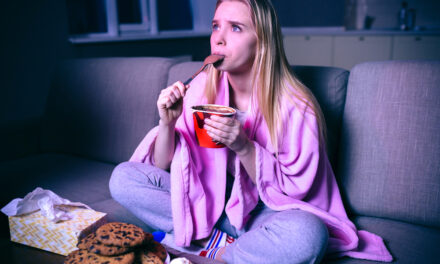How to Make a Positive Digital Impact on Your Children—Especially Around Food

Creating healthy digital habits for your children is one of the hardest tasks modern parents face. This problem seems insurmountable when discussing food. According to a recent study in the journal Pediatrics, kid influencers (ages 3 to 14 years) have outsized sway on what children desire—and when it comes to food, unhealthy products are everywhere. [1]
The researchers of the study sampled 418 YouTube videos by the five most-watched kid influencers of 2019, choosing 179 food- or drink-related videos from this cohort. In total, these videos were watched nearly 48 billion times, with food-related videos viewed one billion times. In order, the video breakdown was as follows:
- Unhealthy branded items, such as McDonald’s, were featured in 90.34% of videos
- Unhealthy unbranded items like hot dogs made up 4.1% of videos
- Healthy unbranded items, such as fruit, 3.1% of the total
- Healthy branded items like Yoplait yogurt, 2.4% of the total
For every 19 influencer-driven unhealthy food-related videos children watched in 2019, they viewed one healthy food product placement.
As the authors note, poor childhood dietary habits put children at an increased risk for cardiovascular disease and type 2 diabetes later in life.[2] Currently, food and beverage companies spend $1.8 billion on youth-targeted marketing. As the above sample data shows, the bulk of advertising dollars is spent on high-sugar processed foods. [3]
Using data provided about viewing habits, over 80% of parents allow their children (age 12 and above) to watch YouTube, with over one-third reporting that their kids regularly watch the platform. [4] Children between the ages of two and eight spend roughly an hour a day on mobile devices; three-fourths of those have access to YouTube. [5]
Unlike the old model of hiring celebrities to promote products, food and beverage companies often rely on influencers. The highest-paid influencer is eight years old. In 2018 and 2019, he earned $26 million for product placements in his wildly popular videos, helping to contribute to the $190 billion in sales each year thanks to “pester power”—children pestering their parents to purchase products they see or hear about. [6], [7]
With this kind of money in play, what can parents do to ensure their children are eating a healthy diet without being swayed by the massive influence of unhealthy food marketing?
Talk openly about nutrition
Parents sometimes feel disempowered when trying to talk about nutrition. Let’s face it: kids are malleable. The influence media platforms hold over their minds can seem to be an impossible obstacle to overcome.
Yet every parent yearns for an active and engaged relationship with their children. This relationship should extend to food choices.
Easier said than done, of course. But there are ways of having honest and impactful discussions.
Don’t label food as “good” or “bad.”
As tempting as this is, you can irreversibly set up your children for eating disorders like orthorexia: a mental labeling system that eliminates foods until very few sources of nourishment remain. Dividing foods that help children “grow big and strong” with “just for fun” snacks creates a better relationship to food without signaling that any category is completely off-limits.
Cook with your children.
Nothing creates a better relationship with mealtime than actually touching, smelling, and creating the food that nourishes them. First off, cooking meals means you’re not relying on processed meals; you’re introducing your children to the ancient alchemical transformation of raw materials into delicious meals. Kids are born creators with wild imaginations. You inspire them to create when you teach them how to cook.
Don’t focus on weight.
Child metabolism can vary wildly. Many chubby children grow up to be healthy adults. Teach them to focus on being strong and healthy, not a certain weight. Our obsessive focus on body mass index (BMI) and toned cover models is toxic to our emotional well-being. Physicality is only one measure of health, and often not the most reliable.
Stop telling them to clean their plates.
This relic from post-war America has got to go. There was a time when food was scarce, and so “finishing” a meal was important. While you don’t want to advocate for wasting food, you want to help your children develop an intuitive sense of eating, which includes stopping when they’re full—or, as the Buddhist practice goes, until their 80% full. Either way, don’t get them used to eating when they’re not hungry.
Create digital hygiene guidelines
Parents have differing guidelines for their children’s device habits. Some limit it to an hour a day. Others won’t let their children have a phone until a certain age. At the extremes, some parents refuse to allow any digital time while others don’t monitor their children’s online world at all. When teenagers average over seven hours a day on their phones, however, we know there’s a problem. [8]
Time spent on a device is only one measure of online health, however. Less discussed is digital hygiene. Do you talk to your kids about how to respond to a bully or troll? Or what those terms mean on social media platforms? Are you helping them to not become one?
Part of the problem is that some parents don’t have great digital hygiene practices; it’s a relatively new concept. Many parents are also addicted to their phones—sometimes, more so than their children. Digital hygiene isn’t only for kids, and it’s hard to teach what you don’t practice.
But what does digital hygiene even mean? In a sense, it goes back to one of humanity’s most sacred spiritual principles: treat others as you want to be treated. Here’s a more updated version: if you wouldn’t say something to someone’s face, don’t type it on a screen.
Digital hygiene is a critical thinking skill. It teaches children (and adults) how to identify potential problems—such as paid influencers trying to sell them unhealthy products. As fun and appealing as “influencers” appear on the screen, we have to remember that they’re not our friends; we’re their potential customers.
Identifying friends and foes was an essential skill for most of human history. It remains so today, even if on TikTok rather than the savannah.
Creating good hygiene practices—thinking critically about digital relationships and how you respond to content (and how you react to people responding to you)—is more important than the amount of screen time. Sure, best practices are needed around digital versus real-life time. Knowing how to act in both is of equal importance for the health of your children and society at large.
Implementing such practices sets your children up for the critical thinking skills they’ll need as they grow older. Everything we consume affects our health, be it sugar or Instagram. Both of those products are fine when used in appropriate doses. Excess is the problem, one that parents should address for the sake of everyone’s health.
Read More:
Author:

Derek Beres
Derek Beres is a multi-faceted author, media expert, and movement instructor based in Los Angeles. He is the author of numerous books, including Global Beat Fusion: The History of the Future of Music and Whole Motion: Training Your Brain and Body for Optimal Health. One-half of the music outfit, EarthRise SoundSystem, he served as music supervisor for the breakthrough documentary, DMT: The Spirit Molecule. Derek is a veteran group fitness instructor at Equinox and a longtime columnist for Big Think. He is the co-host of the Conspirituality podcast.
His new book, Hero’s Dose: The Case for Psychedelics in Ritual and Therapy, is out now.





